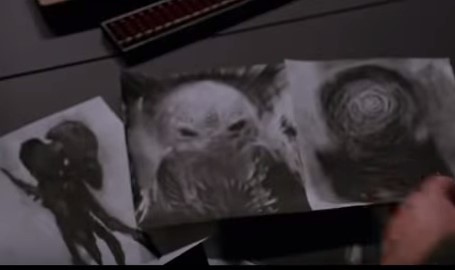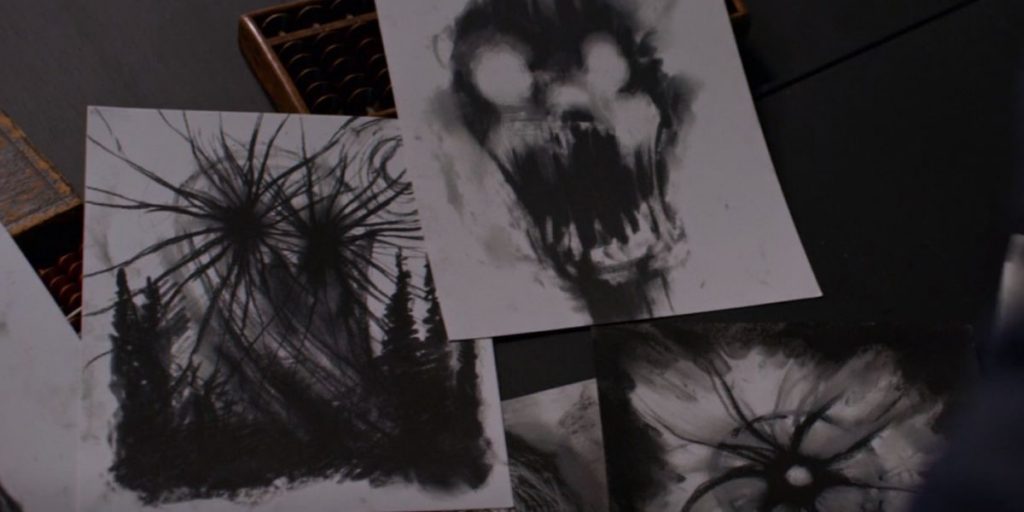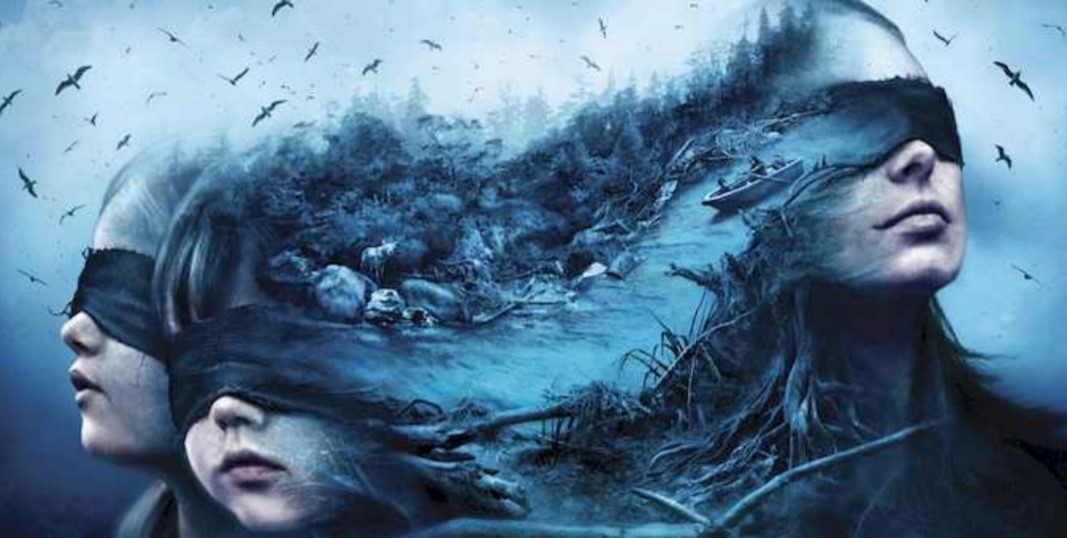Susanne Bier’s Bird Box follows Malorie Hayes as she navigates the events and aftermath of an outbreak of creatures, which seem to take on the form of a person’s worst fear, deepest sadness or greatest loss, and thereby drive humans to suicide when the people look at them. However, the monsters themselves are never seen in the film.
As Malorie discovers throughout her journey, birds seem to be able to detect the creatures’ presence and people affected by it. She therefore keeps three pet birds in a small box. Their ability makes the birds a valuable and even life-saving tool for Malorie, as they can help her and the children to survive. It also portrays the birds as allies to Malorie. The birds are presumable also scared of the creatures, which is why they chirp and flap in their cage when the creatures are near. As Malorie and the children are blindfolded and also the birds are kept in a darkened cage, this has several implications for how important the birds are. For one, Malorie has to trust the birds blindly, both figuratively and actually. As the monsters possess their victims by convincing them to look at them, Malorie always wears a blindfold outside. This means she has to trust not only her hearing, but also the birds which chirp when the monsters are near and thereby warn Malorie of the creatures’ presence.

Birds gain a further significance when Malorie is told that in order to reach a safe haven, she should follow the sound of birds. This is exactly what she tries to do in the sequence. The birds then become not only a tool for survival but also a beacon of hope for Malorie. They are portrayed in contrast to the monsters that possess humans throughout the film. As is shown early on, the monsters have the power to convince humans to commit suicide when they look at a monster directly. The monsters lure people to take off their masks by imitating the voice of a person close to their victim. This makes them particularly effective opponents to the humans as Malorie and the other human characters mostly rely on their sight and their hearing to navigate the world.
The birds literally become Malorie’s “eyes and ears” as she is unable to remove her blindfold and cannot fully trust her hearing, since this can be manipulated by the monsters. She therefore has to rely on the birds, as her life and the lives of the small children depend on the birds’ guidance. One the one hand, Malorie is supposed to follow the birds’ songs, as this is supposed to lead her to the safe haven; on the other hand, the birds’ chirps are an alarm for imminent danger. It is therefore important to analyse why their chirps can have such different meanings. A solution could be that the birds, which Malorie has by her side, are kept in the box or in a cage at all times. This means that the birds are unable to escape or fly away, which explains their wild flattering in the cage accompanying the chirps. Their entrapment aligns with Malorie’s and the children’s state throughout the film. The danger of the monsters restricts Malorie in her movements and her perception of the forest around her. While the birds are unable to follow their instinct and fly away when danger is near, Malorie is unable to look at the monster she is facing. She cannot fight the monsters and her natural instinct to flee is limited due to her restricted perception of her surroundings. The birds’ sounds, which Malorie is supposed to follow to the safe haven, however, are not aggregated sounds, but songs. This seems to align with common perceptions of birds: their songs are usually associated with early summer mornings, a symbol of hope and new beginning [1]. By using this sound as guidance for Malorie and her children to the safe haven, the film effectively associates the birds’ songs, and therefore also the birds themselves with hope and safety.

The opposition between the monsters and the birds, as well as the dilemma human perception become especially intense when Malorie and the children get close to the safe haven. The monsters seem to be very present in this area and start using voices of people close to each character to convince them to take off the blindfolds and look at them. This is interesting in so far, as the monsters seem to turn presumably allied humans into the enemies. The monsters use human instinct, looking, to trick their pray. For most people, looking is the most important way of perceiving the world and navigating it; by using this as a weapon, the monsters force humans to rely on their other senses and perceive the world in a different way. In the film’s climax, Malorie and the children are following the birds’ songs when Malorie trips and falls. She is thereby separated from the children and each of them is tempted by the monsters’ whispers to remove their blindfolds. The monster uses Malorie’s voice to tell Boy to take off his blindfold, while the real Malorie desperately tries to distinguish her voice from the monster’s. As Malorie tries to ignore the voices, they become more aggressive in their demand to remove the blindfold. More interesting is, however, when Girl is lured by the monster, since she is carrying the box with the birds inside.

The non-diegetic music is interrupted by the birds beginning to chirp loudly, and only then does Girl hear the monster using Malorie’s voice. This means that the birds are able to feel the creatures’ presence even before they actively lure their human victims. A close-up of the box containing the birds highlights their distress and the audible chirps that the birds make when the monster is near are very different from the sounds that Malorie and the children follow to the safe haven. Their high-pitched screeches in combination with the sound of flattering wings against the box are clearly agitated sounds that seem to indicate that the birds want to flee and that there is imminent danger. The birds therefore seem to have a sense that humans do not have that warns them earlier. By using the bird chirps in combination with the diegetic sound of the forest, such as leaves rustling and the humans calling each other and mixing them with the whispers of the monsters and non-diegetic music, the film constantly reminds the viewer of the imminent danger that the characters are facing. The birds’ screeching sound has become a warning sign for the characters and therefore the film uses this sound to spread fear among audiences. This means that the birds’ songs are associated with hope and safety and the birds’ chirps with danger. By portraying the birds in these two ways, the birds become symbols of the two contrasts of survival: hope and death.
This scene portrays the monsters not only as dangerous, but also extremely smart beings which know every human they encounter intimately. This can be seen when they imitate Malorie’s voice to lure the children, as Malorie is the closest person to the children and they therefore trust her voice. The same thing can be said for luring Malorie, as the monsters imitate her friends’ voices and become ever more aggressive as Malorie tries to ignore them. It also means that the creatures use effective means to reach their goals, which is to possess humans. This goal stands in direct contrast to the objective of Malorie and most of the friendly characters within the film, whose aim it is to reach the safe haven without witnessing the monster and committing suicide. This makes the monsters not only obstacles in the line of Malorie’s goals, but dangerous antagonists.


“Demons or spirit creatures. […] an entity that takes on the form of your worst fears or your deepest sadness or your greatest loss”- Charlie’s assumption of what the creatures might be
The monsters and the birds are associated with two opposing ideas: the monsters spread fear. They use their abilities to isolate their victims from allies and intoxicate them with enough fear to commit suicide. This means they are acting with a clear goal in mind. They also divide humanity clearly into two categories: those who fear the monsters and then kill themselves and those who believe that seeing the monsters is something beautiful and who want to get other people to witness the monsters. The latter are also portrayed as antagonists and depicted as being crazy, which amplifies the monsters’ antagonist role.

The birds, however, come to be associated with safety and freedom; a place free from fear and isolation. Thy are a symbol of hope and unity among those who fear the monsters. They are also a warning sign, helping Malorie and the children become aware of the creatures’ presence and they therefore help Malorie to navigate. The senses with which they are able to detect the monsters are beyond seeing. The analysed scene is the most important and heightened scene which involves every aspect of the animals and creatures that has been developed throughout the film and makes the characters choose which sound to follow: that of the birds, which means safety and future or that of the monsters, which means fear and death. The diegetic music aids in highlighting the characters’ shifts between these paths.
References
[1] Ratcliffe, E., Gatersleben, B., Sowden, P.T., Associations with bird sounds: How do they relate to perceived restorative potential?, Journal of Environmental Psychology (2016)
Bibliography
Bird Box, (2018), Dir. Susanne Bier, Netflix
Ratcliffe, E., Gatersleben, B., Sowden, P.T., Associations with bird sounds: How do they relate to perceived restorative potential?, Journal of Environmental Psychology (2016)
Picture 1: Promotional poster, Photo: Netflix, Source: comicbook.com <pk49sx73rs9BcTWd49tQ-o.jpg (1500×756) (ptcdn.info)> [Accessed November 13, 2022].
Figure 1: Photo: Netflix, Source: Pop Buzz images <31842 (660×371) (popbuzz.com)> [Accessed November 13, 2022].
Figure 2: Photo: Netflix, Source: Futuro.cl <bird-box-chimuelo-portada-590×340.png (590×340) (futuro.cl)> [Accessed November 13, 2022].
Figure 3: Photo: Netflix, Source: hd-report.com <bird-box-still-4-1280px.jpg (1280×529) (hd-report.com)> [Accessed January 14, 2023].
Figure 4: Photo: Netflix, Source: top-drawing.blogspot.com <what_are_flying_things_that_kill_people_bird_box_why_can_some_see.jpg (455×270) (metro.us) > [Accessed November 13, 2022].
Figure 5: Photo: monica noble, Pinterest <bird-box-monster-drawings.jpg (1200×600) (hypable.com)> [Accessed November 13, 2022].
Figure 6: Photo: Netflix, Source: mirror.co.uk < r6fltl4f2xkl5hjy6uen.jpg (4096×1697) (kinja-img.com)> [Accessed January 14, 2023].
